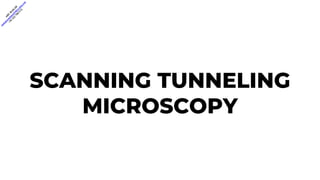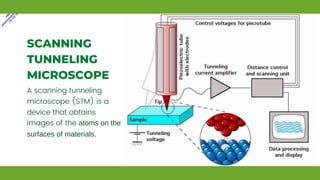SCANNING TUNNELING MICROSCOPY.pptx
- 3. A scanning tunneling microscope (STM) is a device that obtains images of the atoms on the surfaces of materials. SCANNING TUNNELING MICROSCOPE
- 5. ATOMIC SIZED PROBE The STM is not an optical microscope; instead, it works by detecting electrical forces with a probe that tapers down to a point only a single atom across DETECTS ELECTRICAL FORCES
- 6. STM DETECTS IRREGULARITIES ON THE SAMPLE The electron shells, or clouds, surrounding the atoms on the surface produce irregularities that are detected by the probe and mapped by a computer into an image.
- 7. Quantum tunneling STM works on three key principles . Piezo electric effect Feedback current KEY PRINCIPLES
- 8. ŌĆó When the tip is brought very near to the surface to be examined, a bias voltage applied between the two allows electrons to tunnel through the vacuum separating them. ŌĆó The resulting tunneling current is a function of the tip position, applied voltage, and the local density of states (LDOS) of the sample QUANTUM TUNNELING
- 9. PRINCIPLE OF PIEZO ELEMENT. THE APPLIED VOLTAGE MAKES THE ELEMENT LONGER OR SHORTER 5X10-7-5X10-12M,I.E.,A FRACTION OF ONE MICROMETER TO ATOMIC RESOLUTION TRIPOD SCANNER THE COMBINATION OF THREE PIEZO ELEMENTS MAKES IT POSSIBLE TO MOVE THE STM TIP IN THE X-, Y-, AND Z-DIRECTIONS TUBE SCANNER IN MOST MODERN SCANNING PROBE MICROSCOPES, ONE USES A TUBE GEOMETRY.
- 10. ŌĆó The tunneling current is amplified by the current amplifier to become a voltage. ŌĆó Which is compared with a reference value ŌĆó The difference is then amplified to drive the z peizo.
- 11. STM POSITIONING .The phase of the amplifier is chosen to provide negative feedback: If the tunneling current is larger than the reference value, then the voltage applied to the z piezo tends to withdraw the tip from the sample surface, and vice versa.
- 12. Doesnot work with insulators Often needs to used under vacume Able to obtain very high resolution images of conductors and semiconductors Probe tips can be made out of thin wires ADVANTAGES DISADVANTAGES













